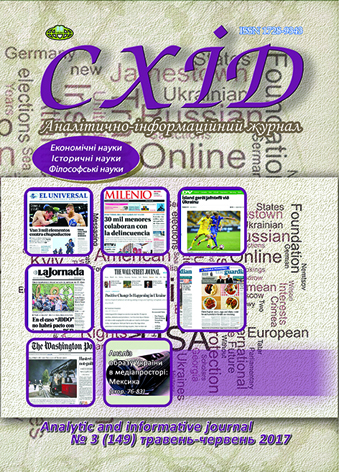Apocalyptic expectations in modern religious literature of Jehovah's Witnesses and Seventh Day Adventists (comparative description)
DOI:
https://doi.org/10.21847/1728-9343.2017.3(149).105375Keywords:
apocalyptic, globalization, protestantism, doomsday, prophecy, eschatology, catastrophe, Judgment, resurrectionAbstract
The article deals with the main apocalyptic themes and motives in the modern religious literature of Jehovah's Witnesses and Seventh-day of Adventists. The relevance of the apocalyptic perspective in the light of the acute problems of the present, in particular, in the context of the global world situation, is indicated. Author analyzed global problems in accordance with certain Biblical signs of "time of the end", apocalyptic feelings and expectations in the religious literature of Jehovah's Witnesses and Seventh-day of Adventists. A comparative analysis reveals the common and distinctive features of apocalyptic themes, plots and moods in the religious literature of Jehovah's Witnesses and Seventh-day of Adventists.
In this research author used general scientific and special methods. The main research approach was the systematic approach, which allowed integrating the diversity of the investigated material into apocalyptic problems in the field of philosophy and theology in order to carry out a coherent definition of the main themes and motifs in the Protestant literature. A comparative method was also used in this research.
The main ideas in the religious literature of Jehovah's Witnesses in this context are: the proclamation of the Second Coming of Christ on Earth during the crisis periods; emphasis on the Millennial Kingdom in the Sky, the opposition of secular power to the Divine Structure. Seventh-day Adventist сoncept: judgment, Second Coming of Jesus Christ, first resurrection and ascension of saints; Armageddon, the devastation of the earth and the destruction of the wicked; Millennial kingdom of the righteous in heaven; The second resurrection and the last judgment; New Land.Downloads
References
Turkoniak [translat.] (2013), The Bible. Books of the Scriptures of the Old and New Testaments, Ukrainian Bible Society, Kyiv (ukr).
Baldwin, D. & Gibson, D. & Thomas, D. (2013), Beyond the imagination, Istochnik szyzni, Zaoksky, 128 p. (rus).
Bugayev, A. (1998), Introduction to a unified theory of the world, Bielyye alvy, Moscow, 320 p. (rus).
Inthe beginning was the Word ... (2002), [transl.], Istochnik szyzni, Zaoksky, 544 p. (rus).
Galli, N. (2006), Christ Coming [transl.], Istochnik szyzni, Zaoksky, 685 p. (rus).
Dokas, V. (2007), The end of the world: Evolution of the Protestant interpretation, Knyhy - XXI, Kyiv-Chernivtsi, 544 p. (ukr).
Zhuklyuk, N. & Lyubaschenko, V. (2003), History of the Church of the Seventh-day Adventist Christians in Ukraine, W.p., Kyiv, 274 p. (rus).
Kolodnyy, A. M. & Lyubovyk, B. O. (1996), Relihiyeznavchyy slovnyk, Chetverta khvylya, Kyiv, 392 p. (ukr).
Lubskyy, V. I. & Horbachenko, T. H. & Nilova, I. D. (1997), Relihiya i kultura, Kyiv, 236 p. (ukr).
Revelation. His magnificent apogee is already close! (1995), Watchtower Bible and tract society; International Bible students association, Brooklyn, New York, 320 p. (ukr).
Price, E. B. (1994), Jehovah’s Witnesses, Seventh-day Adventist Christian Church, Kaliningrad, 176 p. (rus).
Wake up! Our planet is in danger. Can it be saved? (1996, January), Watchtower Bible and tract society; International Bible students associationBrooklyn, New York, p. 12 (rus).
White, E. E. (2002), The Great Fighting between Christ and Satan, The Christian Publishing «Jerelo zyttia», Kyiv, 639 p. (ukr).
White, E. E. (2017), History of salvation [translat.], Istochnik szyzni, Zaoksky 2017, 448 p. (rus).
Christian, Readings (1989), Yearbook of the SDA Church, Moscow, 180 p. (rus).
Is the End Near? (2015), Watchtower Bible and Tract Society of New York, аvailable at: https://www.jw.org/en.
WatchTowerBible and Tract Society. What Does The Bible Really Teach? (2005), Germany.
Downloads
Published
How to Cite
Issue
Section
License
Copyright (c) 2017 Maria Bardyn

This work is licensed under a Creative Commons Attribution-NonCommercial-NoDerivatives 4.0 International License.
1. Authors bear responsibility for the accuracy of facts, quotations, numbers and names used.
2. Manuscripts are not sent back.
3. The publisher does not always agree with the authors' opinion.
4. The authors reserve the right to authorship of the work and pass the first publication right of this work to the journal under the terms of a Creative Commons Attribution-NonCommercial-NoDerivatives 4.0 International License. This license allows others to distribute (copy) the published work for non-commercial purposes, provided there is mandatory attribution to its authors and a link to the first publication in our journal.
5. The authors have the right to conclude separate supplement agreements that relate to non-exclusive work distribution in the form in which it has been published by the journal (for example, to upload the work to the online storage of the journal or publish it as part of a monograph), provided that the reference to the first publication of the work in this journal is included.

